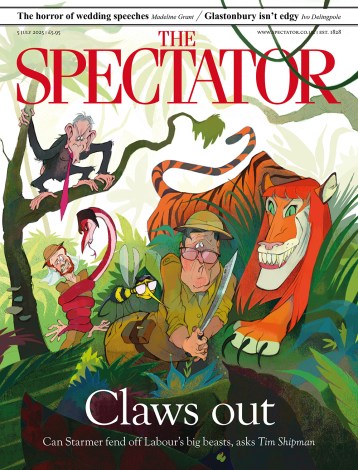To defend my case that Frederick Ashton ought to be acknowledged as one of the major artistic geniuses of the last century, I would adduce three crucial pieces of evidence, garnered from the Royal Ballet’s ‘Ashton Celebrated’ festival at Covent Garden this month.
Oberon and Titania’s love is an open contest between two unyielding wills: it can’t be danced gently
The first is ‘Les Rendezvous’, dating from 1933 and one of his earliest enduring creations. Set in a Victorian park in which some harmless young people meet to flirt and circulate, it provides an object lesson in how to make something supremely but unaffectedly stylish out of a wafer-thin premise. The aim is only to please – there is no undercurrent of melancholy or psychological tension, just a series of lyrical and playful dances evolving out of Auber’s chirpy score, full of ingenious pattern-making, unexpected jokes, subtle inclinations and deviations, twists, turns and pauses, all based in an essentially classical vocabulary and radiating blameless good humour. It achieves a simple perfection: even Ashton himself, a terrible old Eeyore, admitted that it was ‘frightfully good’.
This new production has been handsomely designed in elegant pastel shades by Jasper Conran and sensitively staged by Vanessa Palmer. The idiom doesn’t come naturally to the dancers and the central couple, Fumi Kaneko and Vadim Muntagirov, fell short in sophistication, though they were in assured command of their intricate steps. But Sophie Allnatt, Liam Boswell and Marco Masciari excelled in the perpetuum mobile of a pas de trois that is one of this adorable ballet’s many highlights, and overall the performance infected me with a persistent smile.
‘Five Brahms Waltzes’ is made out of Ashton’s memories of Isadora Duncan, presented by a solo barefoot dancer in a diaphanous chiton. On an empty stage, she skips and runs about as the spirit emerging from the piano moves her.
Carefully choreographed but giving the impression of spontaneity, it could have been faux and banal and faintly ridiculous, yet it touches on the sublime when interpreted by a dancer ready to release herself. Romany Pajdak is one such, flinging herself into Isadora’s musings with a wholehearted joyfulness that never became whimsical.
In ‘The Dream’, an encapsulation of the faery world of A Midsummer Night’s Dream, Ashton envisages Oberon and Titania as wild amoral creatures who struggle to coexist. Their marital quarrel and subsequent reconciliation are movingly portrayed in richly expressive dialogues that embody both their hunger to roam freely and a search for a stability that never quite harmonises. Their love is an open contest between two unyielding wills: it can’t be danced gently.
In the two performances I saw, Marcelino Sambé and Francesca Hayward missed the feral edge that made the roles’ original interpreters Anthony Dowell and Antoinette Sibley so enthralling; Calvin Richardson and Yasmine Naghdi had the sharper attack and requisite touch of menace. Elsewhere in the casts, newbie Caspar Lench and Liam Boswell both dazzled as Puck, and Nicol Edmonds and Leo Dixon had a hilarious set-to as the warring Lysander and Demetrius. (The company’s men are currently exceptionally strong, especially in the middle ranks.)
Some minor works filled out the bill. I don’t rate ‘Rhapsody’ as highly as some: for my taste, it’s too obviously and conventionally a showpiece, brilliant but heartless, despite the palpitating Rachmaninov score. But it was very well danced. Taisuke Nakao showed terrific flair in a virtuoso role conceived for Baryshnikov, and Mayara Magri scintillated in the ballerina’s quick footwork. Excellent supporting ensembles, crisp and stylish, added sparkle. Two extended pas de deux from the 1970s, ‘Hamlet’ and ‘Ophelia’ and ‘A Walk to the Paradise Garden’, lowered the temperature somewhat: mere curiosities, of interest to Ashton completists only. Yet so many more riches await their turn in the stacks: what chance of revivals of ‘Illuminations’, ‘Persephone’ or ‘A Wedding Bouquet’?








Comments